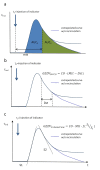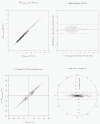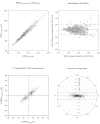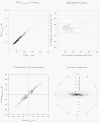Clinical validation of a new thermodilution system for the assessment of cardiac output and volumetric parameters
- PMID: 22647561
- PMCID: PMC3580647
- DOI: 10.1186/cc11366
Clinical validation of a new thermodilution system for the assessment of cardiac output and volumetric parameters
Abstract
Introduction: Transpulmonary thermodilution is used to measure cardiac output (CO), global end-diastolic volume (GEDV) and extravascular lung water (EVLW). A system has been introduced (VolumeView/EV1000™ system, Edwards Lifesciences, Irvine CA, USA) that employs a novel algorithm for the mathematical analysis of the thermodilution curve. Our aim was to evaluate the agreement of this method with the established PiCCO™ method (Pulsion Medical Systems SE, Munich, Germany, clinicaltrials.gov identifier: NCT01405040) METHODS: Seventy-two critically ill patients with clinical indication for advanced hemodynamic monitoring were included in this prospective, multicenter, observational study. During a 72-hour observation period, 443 sets of thermodilution measurements were performed with the new system. These measurements were electronically recorded, converted into an analog resistance signal and then re-analyzed by a PiCCO2™ device (Pulsion Medical Systems SE).
Results: For CO, GEDV, and EVLW, the systems showed a high correlation (r(2) = 0.981, 0.926 and 0.971, respectively), minimal bias (0.2 L/minute, 29.4 ml and 36.8 ml), and a low percentage error (9.7%, 11.5% and 12.2%). Changes in CO, GEDV and EVLW were tracked with a high concordance between the two systems, with a traditional concordance for CO, GEDV, and EVLW of 98.5%, 95.1%, and 97.7% and a polar plot concordance of 100%, 99.8% and 99.8% for CO, GEDV, and EVLW, respectively. Radial limits of agreement for CO, GEDV and EVLW were 0.31 ml/minute, 81 ml and 40 ml, respectively. The precision of GEDV measurements was significantly better using the VolumeView™ algorithm compared to the PiCCO™ algorithm (0.033 (0.03) versus 0.040 (0.03; median (interquartile range), P = 0.000049).
Conclusions: For CO, GEDV, and EVLW, the agreement of both the individual measurements as well as measurements of change showed the interchangeability of the two methods. For the VolumeView method, the higher precision may indicate a more robust GEDV algorithm.
Trial registration: clinicaltrials.gov NCT01405040.
Figures




Similar articles
-
Validation of a new transpulmonary thermodilution system to assess global end-diastolic volume and extravascular lung water.Crit Care. 2010;14(6):R209. doi: 10.1186/cc9332. Epub 2010 Nov 23. Crit Care. 2010. PMID: 21092252 Free PMC article.
-
Performance of a new pulse contour method for continuous cardiac output monitoring: validation in critically ill patients.Br J Anaesth. 2013 Oct;111(4):573-9. doi: 10.1093/bja/aet116. Epub 2013 Apr 26. Br J Anaesth. 2013. PMID: 23625132 Clinical Trial.
-
Assessment of cardiac preload and extravascular lung water by single transpulmonary thermodilution.Intensive Care Med. 2000 Feb;26(2):180-7. doi: 10.1007/s001340050043. Intensive Care Med. 2000. PMID: 10784306
-
Hemodynamic monitoring by transpulmonary thermodilution and pulse contour analysis in critically ill children.Pediatr Crit Care Med. 2011 Jul;12(4):459-66. doi: 10.1097/PCC.0b013e3182070959. Pediatr Crit Care Med. 2011. PMID: 21263372 Review.
-
Global end-diastolic volume an emerging preload marker vis-a-vis other markers - Have we reached our goal?Ann Card Anaesth. 2016 Oct-Dec;19(4):699-704. doi: 10.4103/0971-9784.191554. Ann Card Anaesth. 2016. PMID: 27716702 Free PMC article. Review.
Cited by
-
Evaluation of New Calibrated Pulse-Wave Analysis (VolumeViewTM/EV1000TM) for Cardiac Output Monitoring Undergoing Living Donor Liver Transplantation.PLoS One. 2016 Oct 13;11(10):e0164521. doi: 10.1371/journal.pone.0164521. eCollection 2016. PLoS One. 2016. PMID: 27736921 Free PMC article.
-
A multimodal stacked ensemble model for cardiac output prediction utilizing cardiorespiratory interactions during general anesthesia.Sci Rep. 2024 Mar 29;14(1):7478. doi: 10.1038/s41598-024-57971-6. Sci Rep. 2024. PMID: 38553509 Free PMC article.
-
Physiologic and hemodynamic changes in patients undergoing open abdominal cytoreductive surgery with hyperthermic intraperitoneal chemotherapy.J Int Med Res. 2021 Jan;49(1):300060520983263. doi: 10.1177/0300060520983263. J Int Med Res. 2021. PMID: 33445991 Free PMC article.
-
Comparison of global end-diastolic volume index derived from jugular and femoral indicator injection: a prospective observational study in patients equipped with both a PiCCO-2 and an EV-1000-device.Sci Rep. 2020 Nov 27;10(1):20773. doi: 10.1038/s41598-020-76286-w. Sci Rep. 2020. PMID: 33247165 Free PMC article.
-
Metrology in medicine: from measurements to decision, with specific reference to anesthesia and intensive care.Anesth Analg. 2015 Jan;120(1):66-75. doi: 10.1213/ANE.0000000000000477. Anesth Analg. 2015. PMID: 25625255 Free PMC article. Review.
References
-
- Harvey S, Harrison DA, Singer M, Ashcroft J, Jones CM, Elbourne D, Brampton W, Williams D, Young D, Rowan K. Assessment of the clinical effectiveness of pulmonary artery catheters in management of patients in intensive care (PAC-Man): a randomised controlled trial. Lancet. 2005;366:472–477. doi: 10.1016/S0140-6736(05)67061-4. - DOI - PubMed
-
- Harvey S, Stevens K, Harrison D, Young D, Brampton W, McCabe C, Singer M, Rowan K. An evaluation of the clinical and cost-effectiveness of pulmonary artery catheters in patient management in intensive care: a systematic review and a randomised controlled trial. Health Technol Assess. 2006;10:1–133. - PubMed
Publication types
MeSH terms
Associated data
LinkOut - more resources
Full Text Sources
Medical

